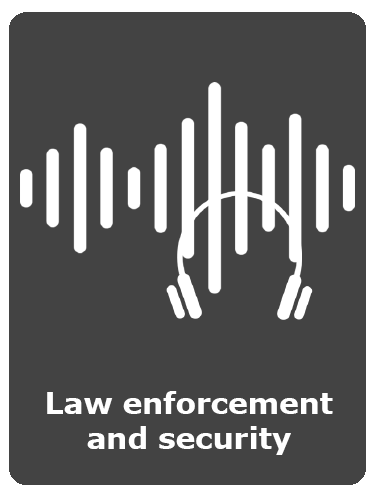Audio forensics on CEDAR Cambridge

Cleaning audio signals for forensic investigation imposes very different requirements from those encountered when restoring audio for broadcast or re-release. In the former case, intelligibility is the overriding criterion; in the latter, listenability is paramount. There are, of course, overlaps between the disciplines. For example, transcription experts can work more effectively and for longer if the material is more listenable, although they will extract more words if the material is more intelligible. Some commentators suggest that enhancing listenability is a simple procedure, satisfied by applying EQ, compression, and gain. This is false, and any from the full arsenal of CEDAR restoration tools may be relevant to a given job, depending upon the types of noises that are obscuring the wanted audio. Nonetheless, enhancing intelligibility often requires further algorithms of the class 'adaptive filters'.
Types of noise encountered in audio forensic investigation
Covert and other surveillance recordings are usually made under less-than-ideal circumstances, so one or more forms of noise will almost always be present. A non-exhaustive list of such noises includes:
- air conditioning noise
- excessive reverberation and echoes
- wind and rain
- road vehicles and aircraft
- engine noise
- domestic appliances such as refrigerators
- live music
- other conversations
- radio and TV
- induced hum and/or buzz from lighting and other sources
- interference from nearby transmitters such as mobile telephones
- faulty microphones and recording equipment
- noise bursts and other impulsive distractions
- induced noise on a recording medium
Some of these noises are best removed using processes such as Debuzz or Declickle, and many are reduced by the judicious use of band-limiting EQ. Others respond best to a broadband noise reduction process such as FNR, or the various forms of adaptive filters, or a hybrid such as Trinity Enhance. On many occasions the best results will be obtained using a combination of processes.
FNR
FNR embodies our most sophisticated algorithm to date, and provides a remarkable amount of noise reduction without destroying the wanted speech. It's also very simple to use. Whether you want to reduce the noise by a few dBs to aid transcription or dig the speech out of a particularly noisy signal or recording to aid intelligibility, FNR will prove to be invaluable.
See FNR
INR
INR is an Impulse Noise Reduction module that was conceived as a more powerful alternative to Declickle. Developed for the audio forensics community, it digs deeper into the signal to remove noise bursts and clicks that conventional declickers cannot.
See INR
Single-channel adaptive filters
Single-channel filters seek to separate the wanted sound (speech) from unwanted sounds (background noise) by identifying the rate of change of components within the overall signal. Because speech changes rapidly, all rapidly varying signal components are deemed to be wanted and are retained. Less rapidly varying components are rejected and are not passed to the output.
See CEDAR Cambridge single-channel adaptive filters
Cross-channel adaptive filters
Cross channel filters separate the desired signal from an obscuring signal such as a radio or TV broadcast by comparing the signal to a reference track containing the interference. The adaptive filter determines which elements of the recording are due to the content within the reference (even if this has been changed significantly by the acts of, for example, transmission or replay) and which elements do not match the reference, and are therefore deemed to be the required signal. To obtain optimum results, the surveillance recording and the reference must be time-aligned, so CEDAR Cambridge provides an additional module to ensure that this is the case.
See CEDAR Cambridge cross-channel adaptive filters
Trinity Enhance Plus
Drawing upon the advances in the latest CEDAR Trinity 6 surveillance system designed for law enforcement and security agencies, Trinity Enhance Plus is a significant update on the original Trinity Enhance module. With two additional filters plus improvements to the existing performance, it now provides six related tools that, using just six sliders, allow you to suppress background noise, reveal voices and increase the intelligibility of speech. It also allows you to enhance the background if that contains wanted detail.
Trinity Enhance
Derived from the original CEDAR Trinity surveillance system, Trinity Enhance remains the simplest way to clean noisy audio for audio forensic use. It provides four related tools that allow you to suppress background noise, reveal voices and increase the intelligibility of speech. It also allows you to enhance the background if that contains wanted detail.
See Trinity Enhance